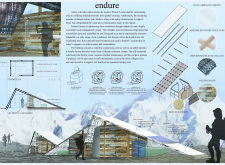5 key facts about this project
Endure addresses the challenges facing high-altitude regions, particularly around Mount Everest. The project aims to provide essential facilities for waste management and sanitation as tourist activity increases. It emphasizes sustainability, adaptability, and resilience, striving to balance the needs of visitors with the delicate environment.
Sustainability and Modularity
The design is built on principles of sustainability and modularity. The structure consists of prefabricated components, allowing for quick assembly on-site. This modular approach makes it easier to adapt to various site conditions in the Gorakshep area, where typical construction methods may not be feasible. By using a modular design, the building can better handle changes in climate and visitor numbers, ensuring long-term functionality.
Waste Management System
A significant aspect of Endure is its controlled waste management system, highlighted by a waterless composting toilet. This toilet design minimizes the ecological impact while maintaining hygiene. The compost produced is reused in nearby villages, supporting local soil health for farming. This approach creates a cycle where waste becomes a resource that benefits the community and environment.
Water and Energy Solutions
Endure incorporates effective water management through a filtered catchment system that collects rainwater and melted snow. This system is vital for providing a consistent water supply in such remote and vulnerable areas. Additionally, solar panels are integrated into the design to generate power for lighting and sanitation needs. These energy solutions reduce reliance on outside resources and enhance the building’s self-sufficiency.
Material Choices
The project favors the use of recycled and reused materials, which helps lower the environmental footprint typically associated with construction. This decision reflects a commitment to sustainability and aligns with the project's goals. Using these materials not only supports ecological health but also demonstrates a responsible approach to building in fragile ecosystems.
The design features a sloped roof that aids in water collection, while the layout remains functional and unobtrusive. This simplicity ensures that the building blends with the surrounding alpine landscape, respecting the unique environment in which it stands.




















































